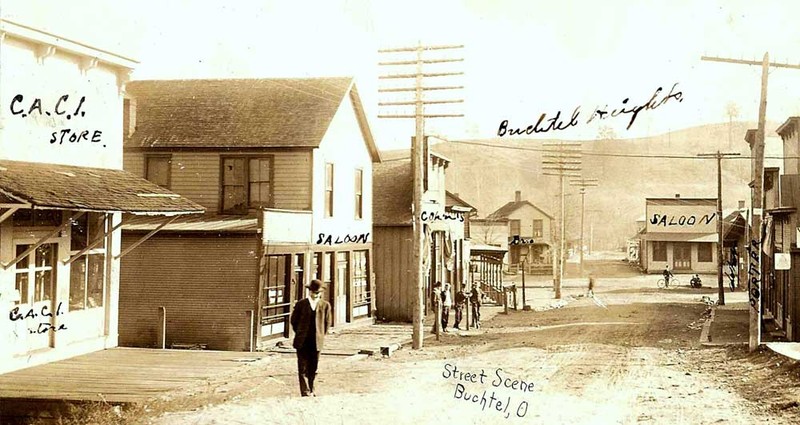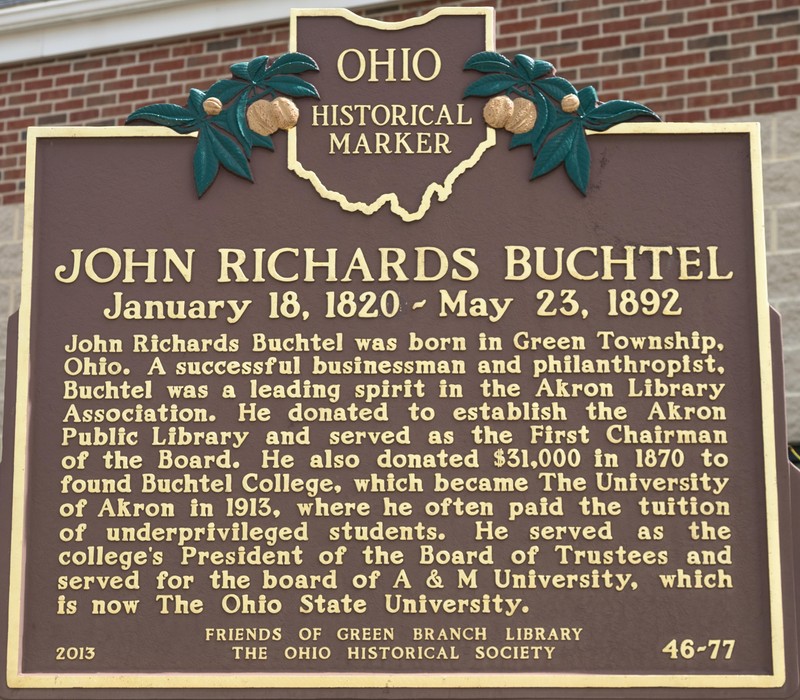John Richards Buchtel Historical Marker
Introduction
Text-to-speech Audio
Dedicated in 2013, this historical marker commemorates John Richards Buchtel, who led the Akron Iron Company and used his fortune to support philanthropic ventures like his support of Akron's libraries. A believer in education, he also established a college that grew to become the University of Akron. The village of Buchtel was established as a result of its proximity to the iron ore and played an instrumental role in the growth and development of the Akron Iron Company.
Images
Hungarian Row in Buchtel

Buchtel in 1882

Buchtel Opera House and General Store

Buchtel Street Scene

This historical marker in Akron honors the founder of Buchtel

Backstory and Context
Text-to-speech Audio
Buchtel was laid out in 1876 by John Richards Buchtel of the Akron Iron Company. Akron Iron Co owned roughly 2,000 acres of land in the Hocking Valley. Given the wealth of mineral resources in the Hocking Valley, the area made an ideal investment for the Akron Iron Company as they used the vast reserves of coal to help grow and develop the company, as coal was needed to fuel the growth of the iron industry. Interestingly, John Richards Buchtel operated his town in a way that exemplified the Gilded Age idea of Christian benevolence.
A successful businessman from Stark County, Buchtel held an important role in the Akron Iron Company. Buchtel established the town around the iron furnace as the town quickly grew. By 1877, the town featured 35 buildings, 70 families, and over 200 workers. By 1880, Buchtel was home to over 400 residents. J.R. Buchtel would donate land for a community cemetery, a local church in addition to a personal donation of 3,000 dollars for a public school to be built. Buchtel gave to many of the community's civic organizations. Despite joining the Syndicate and serving as Vice President, Buchtel donated 10.00 dollars to provide aid to striking miners during the Hocking Valley Coal Strike as well as allowing many union organizations to form in Buchtel. Buchtel was a benefactor of the University of Akron as well as the Akron Library. While the town bears Buchtel's name, Akron Street represents the village's main thoroughfare, further illustrating Buchtel's connection to Akron.
Buchtel could be thought of as a place where Gilded Age leadership met the rough-and-tumble nature of coal-boom communities. Buchtel did represent the idea of a stereotypical wild west town. The Great Hocking Valley Coal Strike of 1884-1885 excavated tensions in the Hocking Valley and caused an air of distrust among insiders and outsiders. The village of Buchtel was no different. The Akron Iron Company elected to hire Pinkerton guards to help protect workers brought in to replace striking miners. As a result, this caused an air of distrust and violence in the town, especially between pro-union miners and strikebreaking miners. Furthermore, what exemplifies Buchtel's rough and tumble nature during the Hocking Valley Coal Strike, many more saloons popped up around the town. Alcohol consumption also illustrated tough times. In 1884 sales of alcohol were $8,703.35 by 1885, and in the midst of the strike, alcohol sales shot up to $12,923.55.
Buchtel provides yet another example of eastern European immigrants making their way to the coalfields of the Hocking Valley. Buchtel was home to a robust Hungarian community who resided along “Hungarian Row”
Sources
, Ohio History Connection. John R. Buchtel, Ohio History Central . Accessed August 10th 2020. https://ohiohistorycentral.org/w/John_R._Buchtel.
Athens County, Ohio Biography John R. Buchtel, genealogytrails.com. Accessed August 10th 2020. http://genealogytrails.com/ohio/athens/bios/bio_johnbuchtel.html.
https://littlecitiesarchive.org/2017/03/29/hungarian-row-buchtel/
https://littlecitiesarchive.org/2017/03/27/buchtel-in-1882/
https://littlecitiesarchive.org/2015/11/07/buchtel-store-and-opera-house/
https://littlecitiesarchive.org/2016/08/26/buchtel-street-scene/
